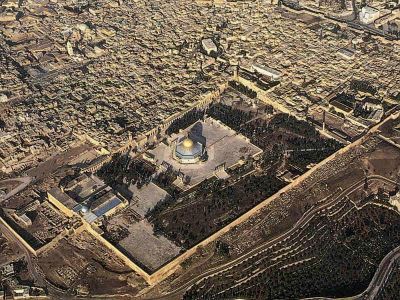 Talk about tiptoeing around the elephant in the living room.
Scores of mainstream journalists are literally trying to walk through a war zone as they cover the current clashes between Israeli police and Palestinians angered by a project to expand some of the pedestrian ramps used by people entering Temple Mount section of Jerusalem. This seems like a rather straightforward story to me, and one of the crucial elements has to be telling readers why this particular location is so important to Muslims and to Jews.
Talk about tiptoeing around the elephant in the living room.
Scores of mainstream journalists are literally trying to walk through a war zone as they cover the current clashes between Israeli police and Palestinians angered by a project to expand some of the pedestrian ramps used by people entering Temple Mount section of Jerusalem. This seems like a rather straightforward story to me, and one of the crucial elements has to be telling readers why this particular location is so important to Muslims and to Jews.
Apparently this task is harder than I thought. Take, for example, the report by Scott Wilson of the Washington Post Foreign Service. The lede says that this conflict centers on "one of this city's holiest sites." Later, we are told that the construction work is near "Haram al-Sharif, a complex of 7th-century mosques and olive groves known by Jews as the Temple Mount." Thus:
The foreign minister of Indonesia, the world's most populous Islamic nation, demanded that Israel immediately halt the work here near the al-Aqsa mosque and Dome of the Rock, where Muslims believe the prophet Muhammad ascended to Heaven, the third-holiest site in Islam.
... Israeli crews began work this week on a damaged access ramp that leads from the Western Wall plaza, where Jews pray at the base of the Temple Mount, to the Mugrabi Gate. The entrance, one of eight to the mosque complex, is used by Israeli soldiers and tourists to reach the plateau where the Second Temple stood until its destruction in A.D. 70.
In other words, if the story states that this is the third-holiest site in Islam, it would also be good to state – perhaps even as high up in the story – that this conflict centers on the holiest site in Judaism. These two facts must be presented together for readers to understand the emotions and history involved in this story. Right?
Actually, the language used in the New York Times report by Greg Myre is much better, although the section I am about to quote comes quite a ways down in the story – just before the end. It would have been good to have some kind of precise reference higher up in the text.
Perhaps the assumption is that anyone reading foreign news in this day and age is the kind of reader who already knows this information (audible sigh). Anyway, Myre does tell us:
The walkway, which is adjacent to the Western Wall, is used primarily by tourists and some Jews to visit the mosque compound, which is built atop the ruins of the biblical Temples.
The walkway was damaged by a snowstorm and an earthquake three years ago and needed to be repaired, according to the Israelis. ... The office of Prime Minister Ehud Olmert said in a statement on Thursday that the renovations "do not constitute any damage to the Mount or Islamic holy places."
. . . But the site is so holy to Jews and Muslims that any action by either side tends to provoke howls of protest. Many Palestinians claim that the Israelis want to destroy the mosque complex and build a new Temple. While some fringe Jewish groups have expressed that desire, the Israeli government says the compound will remain a place for Muslim worship, as it has been for most of the last 1,300 years.
That's enough information, in a daily news report of this length.
I have received some emails from people who say they have seen or heard reports in which there is no material whatsoever about the importance of this site in Jewish tradition and history. Does anyone have any URLs for such a story? Perhaps there are wire reports out there in which the final paragraphs of a longer story have been cut off?
Hey, at least – so far – I have not seen a mainstream news report that links the violence to the influence of the Left Behind novels on U.S. foreign policy. Then again, I have not been listening to the BBC.
